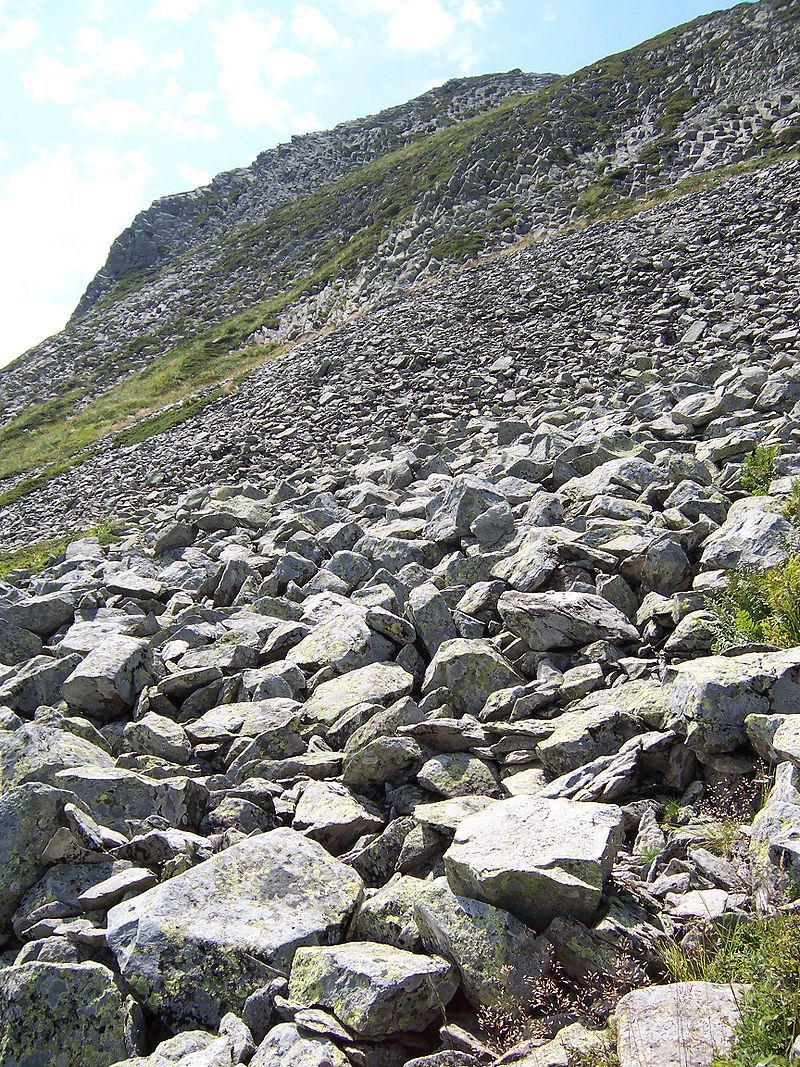
 Comme presque tous les sommets qui l’entourent, le Gerbier de Jonc est en phonolite, une roche que l’on surnomme « la pierre qui chante ».
Comme presque tous les sommets qui l’entourent, le Gerbier de Jonc est en phonolite, une roche que l’on surnomme « la pierre qui chante ».
Sur quelques 55 kilomètres autour du Mont Gerbier de Jonc, on ne compte pas moins de 180 points de sortie de laves phonolitiques (dont une centaine de dômes). Ils sont à l’origine des paysages alentours. Un géographe a évoqué la région comme « une des contrées les plus étranges de France, vaste plateforme herbeuse toute hérissée de cônes et de pitons phonolithiques, dépassant les 1 500 m »… Afin de comprendre les paysages aux alentours, il faut savoir que 2 épisodes volcaniques se sont succédé. Entre -10 et -8 Ma, des coulées de laves basaltiques fluides s’étalent et forment un vaste plateau. Entre -8 et -6 Ma, des laves pâteuses, trachytes et phonolites, s’immiscent à travers ce plateau pour former les sucs.
Rappel géologique
La phonolite est issue d’une lave plutôt claire, pauvre en fer et en magnesium, riche en silice. L’espect de la roche varie en fonction de la composition initiale du magma, de son évolution dans la chambre magmatique et des conditions de refroidissement de la lave. Il y a donc autant de phonolites que de sucs phonolitiques.
Les nuances sont parfois tenues, ici un peu plus bleue, là un peu plus grise. La phonolite peut se débiter en dalles qui, taillées, forment les lauzes qui sont posées sur les toits. La couleur des toitures correspond alors à celle des monts alentours.
Comme son nom l’indique, la phonolite a la propriété d’être sonore lorsqu’on la frappe. C’est dû au fait que les minéraux ont tous la même orientation, un peu comme le fil du bois. Cela guide les chocs et le son.
 Like almost of the peaks which surround it, the Gerbier de Jonc is made of phonolite, a rock called “clinkstone” in English and “the singing stone” in French.
Like almost of the peaks which surround it, the Gerbier de Jonc is made of phonolite, a rock called “clinkstone” in English and “the singing stone” in French.
In just 55 kms, there are nearly 180 phonolitic lava vents (a hundred of witch are domes). There are the reason for the spectacular landscapes all around. A geographer described the area as “one of the strangests regions of France, a vast grassy platform stipped with cones and phonolitic pitons at an altitude of over 1,500 meters”… To understand the landscape all around, here have been two volcanic episodes. Between 10 and 8 millions year ago, fluid basaltic lava flows spread out and created a vast plateau. Between 8 and 6 millions years ago, pasty, trachytic and phonolitic lavas flows up through the plateau to form the “sucs”.
Geological reminder
Phonolite is light-couloured lava with a low iron and magnesium content but rich in silica. The aspect of the rock varies depending on the initial composition of the magma, its evolution in the magmatic chamber and the conditions in which the lava cooled. In fact there are as many phonolites as there are phonolitic hillrocks. That over times, there have been
The hues vary too, sometimes a little more blue, at other times a little more gray. Phonolite can be cut into flat slabs and used to make roof tiles. The color of the roof here matches the neighboring mountains.
As it name indicates, phonolite enchants as it clinks when struck. It is because the minerals in its composition are all orientated in the same direction, like the grain in wood. That polarization guides the sound when you strike a piece.
D'après vos observations et à l'aide du descriptif,
Questions to validate this earthcache:
Based on your observations and using the description,
WP 0
Joindre à votre log une photo de vous, votre GPS, votre GC perso ou tout autre objet vous représentant aux coordonnées (sans donner les réponses !).
Les simples photos du mont Gerbier de Jonc ne permettent de valider cette condition de log.
Cette tâche est obligatoire et autorisée par les guidelines mises à jour en juin 2019.
Attach to your log a photo of you, your GPS, your personal GC or any other object representing you in the coordonates (without showing the answers !).
The simple photos of the Mount Gerbier de Jonc do not validate this log condition.
This task is mandatory and allowed by the guidelines updated in june 2019.
WP 1
. Rendez-vous aux coordonnées du waypoint. Il y a 2 pierres dressées. Frappez-les avec votre marteau de Géologue (ou une pierre trouvée sur place) et écoutez bien. Dîtes-nous laquelle de la pierre A ou de la B est de la phonolite ?
. Go to the coordinates of the waypoint. There are 2 standing stones. Hit them with your geologist's hammer (or a stone found on the spot) and listen carefully. Tell us which of the A or B stone is phonolite?
Envoyez-moi vos propositions de réponses soit via mon profil, soit via la messagerie geocaching.com (Message Center) PUIS loguez cette cache "Found it", je vous contacterai en cas de problème.
La condition principale pour loguer une Earthcache étant de répondre aux questions posées dans le descriptif, tout log "Found it" enregistré sans envoi préalable de vos propositions de réponses sera supprimé. Il en sera de même pour les logs enregistrés sans la photo requise.
Send me your proposals for answers either via my profile or via the geocaching.com messaging (Message Center) THEN log this cache "Found it", I will contact you in case of problem.
The main condition to log an Earthcache is to answer the questions asked in the description, any log "Found it" registered without prior submission of your proposals of answers will be deleted. It will be the same for logs saved without the required photo.